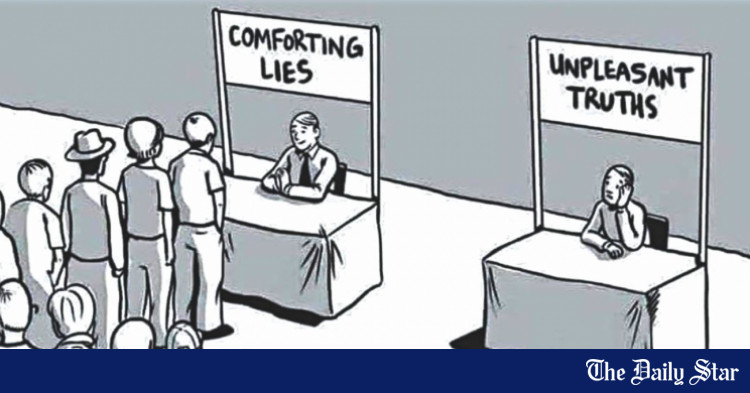Cognitive Dissonance
 Graphics courtesy of The Daily StarOpens in new window
Graphics courtesy of The Daily StarOpens in new window
Cognitive dissonance is a feeling of discomfort that occurs when one holds two conflicting ideas at the same time. The ideas may include attitudes, beliefs, values, and awareness of one’s actions. |
Often the dissonance is between a belief or attitude on one hand and a behavior (ongoing or already performed) that contradicts those beliefs on the other hand. For example, a manager who has to fire people as part of her job may experience cognitive dissonance if she thinks of herself as a kind person and she has to fire people she thinks are good people or good workers.
Another example would be an individual who believes strongly in living in a healthy fashion but has been taking 30 pills of prescription pain medications every day for several years.
| In the fable of the fox and the grapes (sometimes attributed to Aesop), a fox comes upon a grape orchard and tries to obtain some ripe grapes. When he is unable to reach the grapes after many attempts, he leaves and rationalizes his situation: he says that he did not really want the grapes and that they were probably sour anyway. This story is used to illustrate the concept of cognitive dissonance, when an individual (in this case, the fox) is unable to hold incompatible ideas simultaneously (e.g., wanting grapes but being unable to get them). To reduce cognitive dissonance, the individual alters one of the incompatible beliefs (in this case, rationalizing that he does not really want the grapes). |
Since dissonance is uncomfortable, people are motivated to reduce it. As Festinger (1957) described, dissonance can be reduced by stopping the behavior, changing the dissonant belief through either removing it or reducing its importance, or adding new consonant belief (one that is not in conflict with the behavior).
As changing behavior can be difficult, people often choose to change their beliefs rather than changing their behavior. For instance, in the case of the woman who takes prescription pain medication, she could reduce cognitive dissonance by quitting her drug habit, but this would be very difficult.
Another possibility is to choose to believe that taking 30 painkillers every day is not unhealthy. A variant of this is to rationalize the drug habit, for instance, by thinking that many people are addicted to painkillers and only a few actually overdose or develop liver failure, or that her dosage is not high enough to cause problems, or that she is eventually going to die of something and it is likely that something other than the drug addiction will kill her.
As another example, she could add a consonant belief to the dissonant ideas by, for example, stressing the benefits of the drug use. She could focus on how relaxed she has been since taking the pills or how she finally gets more sleep.
American psychologist Leon Festinger and colleagues first studied cognitive dissonance in the 1950s, chronicling their research in the 1956 book When Prophecy Fails (Festinger, Riecken, & Schachter, 1957).
Festinger and colleagues had covertly infiltrated a cult that held the belief that the end of the world was near. The cult leader claimed that on a particular day in 1954, the earth would experience a massive and devastating flood. Cult members would be saved by beings from another planet, who would arrive in spaceships before doomsday and bring them to safety on another planet.
Festinger wondered what would happen to the cult members when doomsday passed by with no flood and no rescuers. Consistent with his new cognitive dissonance theory, he hypothesized that cult members would become even more loyal to one another and their beliefs rather than quitting the cult and coming to their senses.
Festinger reasoned that these individuals had given up a great deal to become cult members (many had lost homes, spouses, careers, and friends). It would create extreme dissonance if an individual, knowing his sacrifice, also believed that the sacrifice had been made for a ridiculous reason.
Festinger’s prediction was correct; although some people left the cult after “doomsday” passed uneventfully, most became even more passionate in their beliefs. The group leader had created an explanation that allowed members to rationalize their continued allegiance to the group: God had called off the disaster because of the goodness and devotion of the cult members.
Cognitive dissonance has been used to explain a wide array of human behaviors that many people find puzzling, including why people stay with romantic partners who physically harm them and why we are extremely loyal to groups that require hazing rituals to gain membership (e.g., fraternities and sororities). In situations such as these , people have to explain to themselves why they would suffer such pain; they often reason that the willingness to experience pain is a sign of how much they love the individual or group that has caused it.
See also:
- Cooper, J. (2007). Cognitive dissonance: 50 years of a classic theory. London: Sage.
- Festinger, L. (1957). A theory of cognitive dissonance. Stanford, CA: Stanford University Press.
- Festinger, L., Riecken, H. W., & Schachter, S. (1956). When prophecy fails. Minneapolis: University of Minnesota Press.
- Tavris, C., & Aronson, E. (2007). Mistakes were made (but not by me): Why we justify foolish beliefs, had decisions, and hurtful acts. Orlando, FL: Harcourt.

